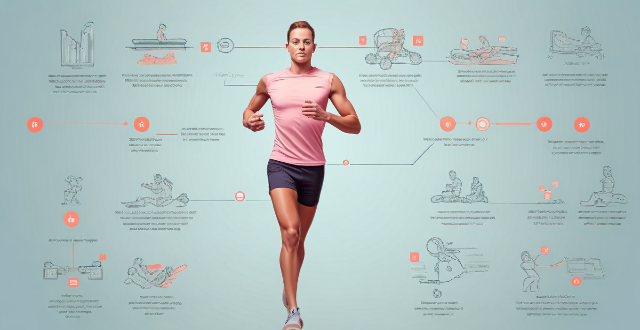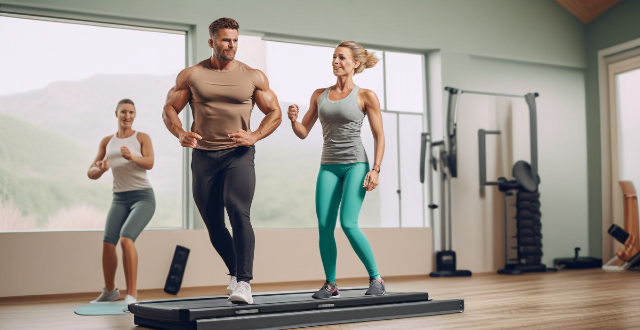Heart Intensity

How can I use heart rate monitoring to improve my workout routine ?
Using a heart rate monitor can significantly improve your workout routine by providing valuable insights into your body's response to exercise. Here's how you can leverage heart rate monitoring to optimize your fitness regimen: - Understanding Heart Rate Zones: Your heart rate varies depending on the intensity of your workout. By understanding these heart rate zones, you can tailor your workouts to achieve specific goals, such as fat burning, endurance building, or performance improvement. - Setting Goals Based on Heart Rate: Establish clear objectives for each workout session based on your heart rate data, such as endurance training, weight loss, or performance enhancement. - Tracking Progress: Consistently monitor your heart rate during workouts to track progress, including recording resting heart rate and assessing recovery time. - Adjusting Intensity: Modify your workout intensity based on your heart rate feedback, such as increasing intensity if you're consistently below your target heart rate zone or decreasing intensity if you're above it. - Preventing Overtraining: Use heart rate data to avoid overtraining by staying within recommended heart rate limits and recognizing signs of overexertion. - Personalizing Your Workouts: Customize your routine with heart rate in mind by incorporating different training methods and experimenting with different activities to see which ones give you the desired heart rate response.

What is the ideal heart rate for different types of exercises ?
When it comes to exercise, knowing your ideal heartWhen it comes to exercise, knowing your ideal heartimizing the benefits of your knowing your ideal heart rate is crucial for maximizing the benefits of your workout while minimizing the risk of injury. The recommended heart rate ranges vary depending on the type of exercise and your fitness level. For aerobic exercise, beginners should aim for 50-60% of their maximum heart rate (MHR), intermediate exercisers 60-70% of MHR, and advanced exercisers 70-85% of MHR. High-intensity interval training (HIIT) requires higher intensity, with beginners aiming for 70-80% of MHR, intermediate exercisers 80-90% of MHR, and advanced exercisers 90-100% of MHR. Resistance training also varies by fitness level, with beginners aiming for 50-60% of MHR, intermediate exercisers 60-70% of MHR, and advanced exercisers 70-85% of MHR. Yoga and Pilates are low-impact exercises that focus on flexibility, balance, and core strength, with beginners aiming for 40-50% of MHR, intermediate exercisers 50-60% of MHR, and advanced exercisers 60-70% of MHR. By monitoring your heart rate and staying within the recommended ranges, you can ensure that you're exercising safely and effectively.

How often should seniors engage in aerobic activities for heart health ?
Engaging in regular aerobic activities is crucial for seniors to maintain heart health and overall well-being. The American Heart Association recommends at least 150 minutes of moderate-intensity or 75 minutes of vigorous-intensity aerobic activity per week, spread throughout the week. For seniors, this could include brisk walking, swimming, or biking for at least 30 minutes five days a week (moderate intensity) or running and fast cycling for at least 25 minutes three days a week (vigorous intensity), depending on their capability and medical restrictions. Regular aerobic activity offers numerous benefits for seniors, including improved cardiovascular fitness, better blood pressure and cholesterol levels, weight management, increased muscular strength and endurance, and boosted mental health. However, safety precautions should be taken, such as consulting with a healthcare provider before starting an exercise program, starting slowly, choosing low-impact exercises, staying hydrated, wearing appropriate clothing and footwear, and monitoring bodily responses to the activity. By following these guidelines and taking necessary precautions, seniors can significantly improve their quality of life and maintain their independence longer.

Are there any risks associated with constantly monitoring heart rate during exercise ?
Monitoring heart rate during exercise is common but can pose risks like over-reliance on technology, psychological impacts, and physical risks. It's important to find a balance between using heart rate data and listening to your body's signals for a safe and enjoyable workout.

Can heart rate monitoring help prevent overexertion during exercise ?
Overexertion during exercise can lead to fatigue, muscle soreness, and injuries. Heart rate monitoring is a technique used to measure the number of times a person's heart beats per minute (bpm). By monitoring your heart rate, you can determine personalized training zones based on age, fitness level, and goals, providing real-time feedback on current heart rate during exercise. Recovery time is essential for preventing overexertion, and heart rate monitoring helps determine how long it takes for the body to return to its resting state. Best practices for heart rate monitoring include choosing the right device, calibrating regularly, warming up properly, staying hydrated, and listening to your body. Following these guidelines and listening to your body can help prevent overexertion during exercise while maximizing its benefits.

How often should I check my heart rate while exercising ?
Checking your heart rate is an important part of staying healthy and fit. However, how often you should check it depends on several factors, including your age, fitness level, and overall health. Here are some guidelines to help you determine the optimal frequency for checking your heart rate during exercise: For beginners: Check your heart rate every five minutes during the first few weeks of training to get a sense of your target heart rate range and adjust accordingly as you become more comfortable with the activity. For experienced athletes: Once or twice per workout is sufficient for experienced athletes who have established a good foundation in their fitness routine. This will allow them to focus more on their form and intensity without constantly worrying about their heart rate. For older adults or those with pre-existing health conditions: Older adults or those with pre-existing health conditions may need to monitor their heart rate more frequently than younger individuals. It's recommended that they check their heart rate at least once per workout and perhaps even before and after each session to stay safe and ensure they're not overexerting themselves.

In what ways can heart rate monitors improve athletic training ?
Heart rate monitors significantly enhance athletic training by enabling targeted intensity, objective data analysis, recovery monitoring, pacing strategies, and individualized training. To use them effectively, athletes should establish baseline measurements, set clear goals, create a structured plan, continuously monitor progress, and incorporate technology for easy tracking and insights.

How does high-intensity interval training (HIIT) affect cardiorespiratory fitness ?
High-intensity interval training (HIIT) is a form of exercise that involves short bursts of intense activity followed by periods of rest or low-intensity exercise. This type of training can improve cardiorespiratory fitness by increasing the heart rate and improving blood flow throughout the body, leading to improved muscle performance and endurance. HIIT also helps to burn calories and fat, making it an effective way to promote weight loss. Additionally, HIIT workouts can be done in a shorter amount of time than other forms of exercise, making it a great option for those who are short on time but still want to stay active and healthy. Overall, incorporating HIIT into your workout routine can provide numerous benefits for your cardiorespiratory fitness and overall health.

What are the benefits of monitoring heart rate during exercise ?
Monitoring your heart rate during exercise offers numerous benefits, including improved workout efficiency, better recovery, reduced risk of injury, increased motivation, and improved cardiovascular health. By keeping an eye on your heart rate, you can ensure you're getting the most out of every workout while also taking care of your body.

Can physical activity reduce the risk of heart disease ?
Regular physical activity can significantly reduce the risk of heart disease by improving blood circulation, strengthening heart muscles, and reducing major risk factors such as high blood pressure, high cholesterol, and diabetes. Recommended types of exercise include aerobic activities and strength training. Following guidelines from health organizations like the WHO can help maintain cardiovascular health.

How does exercise physiology explain the benefits of high-intensity interval training (HIIT) ?
High-intensity interval training (HIIT) is a form of exercise that involves short, intense bursts of activity followed by periods of rest or low-intensity exercise. From an exercise physiology perspective, HIIT offers numerous benefits, including increased metabolic rate, improved cardiovascular health, muscle development and endurance, favorable hormonal responses, mental health advantages, reduced injury risk, and time efficiency. These factors make HIIT a popular and effective method for achieving various fitness goals.

How can I monitor my heart rate during exercise for optimal health results ?
Monitoring your heart rate during exercise is crucial for efficiency, safety, and progress tracking. Tools include heart rate monitors, smartphone apps, fitness trackers, and chest straps. Before starting, consult a doctor and choose the right tool. During exercise, wear your monitor, warm up, stay in your target heart rate zone, adjust intensity, and cool down. After exercise, record data, analyze results, and rest. Best practices include calibrating devices, staying hydrated, being consistent, and listening to your body.

What is the best way to monitor heart rate during exercise ?
Monitoring heart rate during exercise is crucial for staying healthy and achieving fitness goals. The best way to monitor heart rate during exercise depends on personal preferences and fitness goals. Wearable heart rate monitors are convenient and non-invasive, while chest straps provide accurate data. Fingertip devices are affordable and easy to use, but less accurate than other methods. Smartphone apps are free or inexpensive, but may not work well in certain situations. Ultimately, the choice between these methods should be based on individual needs and preferences.

Is it safe for elderly people to engage in high-intensity workouts ?
The safety of high-intensity workouts for elderly people depends on various factors such as health status, fitness level, balance and coordination, recovery time, and necessary modifications and adaptations. It is essential to consult with a healthcare professional before starting any exercise program.

How does age affect heart rate during exercise ?
Age affects heart rate during exercise by altering the structure and function of the aging heart, reducing maximum heart rate, shifting autonomic regulation towards sympathetic dominance, and decreasing cardiac reserve. Older individuals can still improve their cardiovascular fitness through regular exercise and lifestyle modifications.

Is there a specific duration or intensity of exercise needed to improve immune function ?
The relationship between exercise and immune function is complex, but research suggests that regular physical activity can enhance the immune system. However, both the duration and intensity of exercise play significant roles in achieving this beneficial effect. The American Heart Association recommends at least 150 minutes of moderate-intensity aerobic activity or 75 minutes of vigorous-intensity activity per week for adults. Engaging in prolonged periods of endurance exercise can temporarily suppress immune function due to increased stress on the body. Light activities like walking or yoga can still offer immune benefits by reducing stress and promoting overall health. Regular moderate to high-intensity exercises, such as jogging, cycling, or strength training, are generally considered optimal for enhancing immune function. Adequate rest and recovery are crucial for maintaining a healthy immune system. Combining different types of exercises (aerobic, strength training, flexibility work) can provide a well-rounded approach to enhancing immune function. Staying hydrated and consuming a balanced diet rich in nutrients supports both exercise performance and immune health. Other lifestyle habits, including sleep quality, stress management, and avoidance of harmful substances, also play a vital role in supporting immune function alongside exercise.

Is high-intensity interval training (HIIT) beneficial for reducing stress ?
The text discusses the potential benefits of High-Intensity Interval Training (HIIT) for stress reduction, including releasing endorphins, improving cardiovascular health, boosting self-confidence, enhancing focus and concentration, and providing a sense of accomplishment. It also provides tips for incorporating HIIT into a routine, such as starting slowly, choosing enjoyable activities, setting realistic goals, incorporating recovery time, and seeking professional guidance.

Is it safe to start an exercise program if you have a history of heart problems ?
Starting an exercise program is generally beneficial for overall health, but it's important to take precautions if you have a history of heart problems. Here are some factors to consider: 1. Consult with your doctor before starting any exercise program, especially if you have a history of heart problems. 2. Start slowly and gradually increase the intensity and duration of your workouts over time. 3. Choose low-impact exercises such as swimming, cycling, or yoga to improve cardiovascular health without putting too much strain on your heart. 4. Monitor your symptoms during and after exercise, and stop immediately if you experience any symptoms such as chest pain, shortness of breath, or dizziness. 5. Stay hydrated and nourished by drinking plenty of water and eating a healthy diet that includes plenty of fruits, vegetables, whole grains, and lean proteins.

Are there any risks associated with high-intensity workouts for seniors, especially in a group setting ?
High-intensity workouts in a group setting pose certain risks for seniors, including cardiovascular strain, musculoskeletal stress, overexertion and fatigue, and social and psychological factors. To minimize these risks, seniors should consult with a healthcare professional, start slowly and gradually increase intensity, focus on low-impact activities, stay hydrated and monitor temperature, wear appropriate footwear and clothing, listen to their body, and seek supervision from qualified instructors.

Is it necessary to do a warm-up even for low-intensity workouts ?
A proper warm-up is crucial for any workout, including low-intensity exercises. It increases blood flow and oxygenation, raises muscle temperature, improves range of motion, primes the nervous system, reduces injury risk, and boosts performance. Even for gentle activities like walking or yoga, a warm-up enhances mental focus, gradually activates muscles, promotes consistency, supports joint health, and eases into stretching. Warm-up ideas include walking, dynamic stretching, Tai Chi movements, Pilates exercises, and deep breathing or meditation. Incorporating a warm-up before any workout is essential for maximizing performance, reducing injury risk, and enhancing overall health benefits.

What are some common mistakes people make when monitoring their heart rate during exercise ?
When monitoring heart rate during exercise, common mistakes include incorrect sensor placement, over-reliance on technology, misinterpreting data, not tracking recovery time, and ignoring other factors. It's important to wear the sensor correctly, understand technology limitations, consider individual differences, track recovery time, and take environmental and medication factors into account for accurate readings.

Can exercise reverse heart disease ?
Heart disease is a major cause of death worldwide, and it can be devastating to those affected. While there are many treatments available for heart disease, including medication and surgery, some people wonder if exercise can reverse the damage caused by heart disease. There is evidence that regular exercise can help prevent and manage heart disease by improving cardiovascular health, managing weight, lowering blood pressure, improving cholesterol levels, and reducing stress. However, there is no conclusive evidence that exercise can completely reverse heart disease. Despite this, there are still many benefits to regular exercise for heart health. If you have been diagnosed with heart disease or are at high risk for developing it, talk to your doctor about starting an exercise program. They can help you create an exercise plan that is safe and effective for your individual needs and goals.

How can I avoid injury after a high-intensity workout
To avoid injury after a high-intensity workout, it is important to warm up properly, stretch, use proper form, take breaks, stay hydrated, and wear appropriate clothing. These tips will help reduce the risk of injury and allow you to continue enjoying the benefits of high-intensity workouts.

How accurate are fitness trackers in monitoring heart rate ?
The accuracy of fitness trackers in monitoring heart rate can be affected by various factors, including device quality, skin type and color, movement, and environmental factors. To improve the accuracy of your fitness tracker's heart rate monitor, it is recommended to choose a reputable brand with advanced sensors and algorithms, wear your device correctly, calibrate your device, and use multiple sensors or a chest strap for better results. By following these tips, you can make more informed decisions about your health and fitness goals.

How long should my aerobic workouts be ?
Aerobic exercises, or cardio workouts, are vital for overall health and fitness. The American Heart Association recommends at least 150 minutes of moderate-intensity activity or 75 minutes of vigorous activity per week. This can be broken down into shorter sessions throughout the day. Starting slow and gradually increasing duration and intensity is advised. Mixing up activities helps prevent injury and keeps workouts interesting. Benefits include improved cardiovascular health, weight management, mood enhancement, and a stronger immune system. Always consult with a healthcare professional before starting any new exercise regimen.

Heart and lungs are better, healthier and longer, which can promote the exercise of heart and lung function

How does climate variability impact the frequency and intensity of extreme weather events like floods and hurricanes ?
Climate variability, which can be natural or human-induced, has a significant impact on the frequency and intensity of extreme weather events such as floods and hurricanes. Changes in rainfall patterns, sea level rise, and land use changes can increase the risk of flooding, while warmer ocean temperatures, atmospheric conditions, and El Niño Southern Oscillation (ENSO) can affect hurricane formation and intensity. As our planet continues to warm due to human activities, it is crucial that we take steps to mitigate the impacts of climate change and adapt to its effects on our environment and communities.

Can aerobic exercise improve my cardiovascular health ?
Aerobic exercise is essential for maintaining and improving cardiovascular health, offering benefits such as strengthened heart muscle, lowered blood pressure, increased HDL cholesterol, reduced inflammation, weight management, improved circulation, and better blood sugar regulation. Regular aerobic activities like walking, jogging, cycling, swimming, or group fitness classes can significantly enhance overall heart health. The American Heart Association recommends at least 150 minutes of moderate-intensity aerobic exercise weekly, spread throughout the week, to achieve these benefits.

How often should I exercise to see weight loss results ?
To see weight loss results, start with low-intensity workouts and gradually increase intensity over time. Aim for at least 150 minutes of moderate-intensity exercise per week, mix up your workouts, and incorporate strength training. Consistency is key!